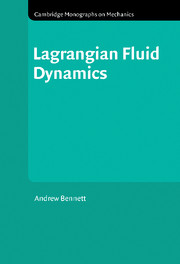Book contents
Introduction
from PART I - THE LAGRANGIAN FORMULATION
Published online by Cambridge University Press: 06 July 2010
Summary
Kinematics, statistics and dynamics: these are the basic elements of fluid dynamics. The Lagrangian formulation of the conservation laws for mass, momentum and energy are familiar to fluid dynamicists, as it is the natural way to extend Newtonian particle dynamics to fluids. Less familiar are: the conservation law for particle identity, which is effectively a definition of the independent Lagrangian variables; the path integral relationship between the statistics of random dependent Lagrangian variables and their Eulerian counterparts; the first integrals of Cauchy and Weber for the inviscid Lagrangian momentum equations, and the Cauchy vector invariant; the boundary conditions that must be imposed on compressible flow at boundaries defined by fluid particles (comoving boundaries), and the increasingly useful Lagrangian conservation law for momentum when the particle position is expressed in radial distance, longitude and latitude. The complexity of the divergence of the viscous stress tensor expressed in Lagrangian variables is undeniable, but the structure emphasizes the status of the Jacobi matrix as the Galilean invariant state variable that characterizes the flow. The Cauchy invariant is algebraically related to the Jacobi matrix and its Lagrangian time derivative; the conservation law for the Cauchy invariant in viscous flow is almost elegant.
- Type
- Chapter
- Information
- Lagrangian Fluid Dynamics , pp. 3 - 4Publisher: Cambridge University PressPrint publication year: 2006



